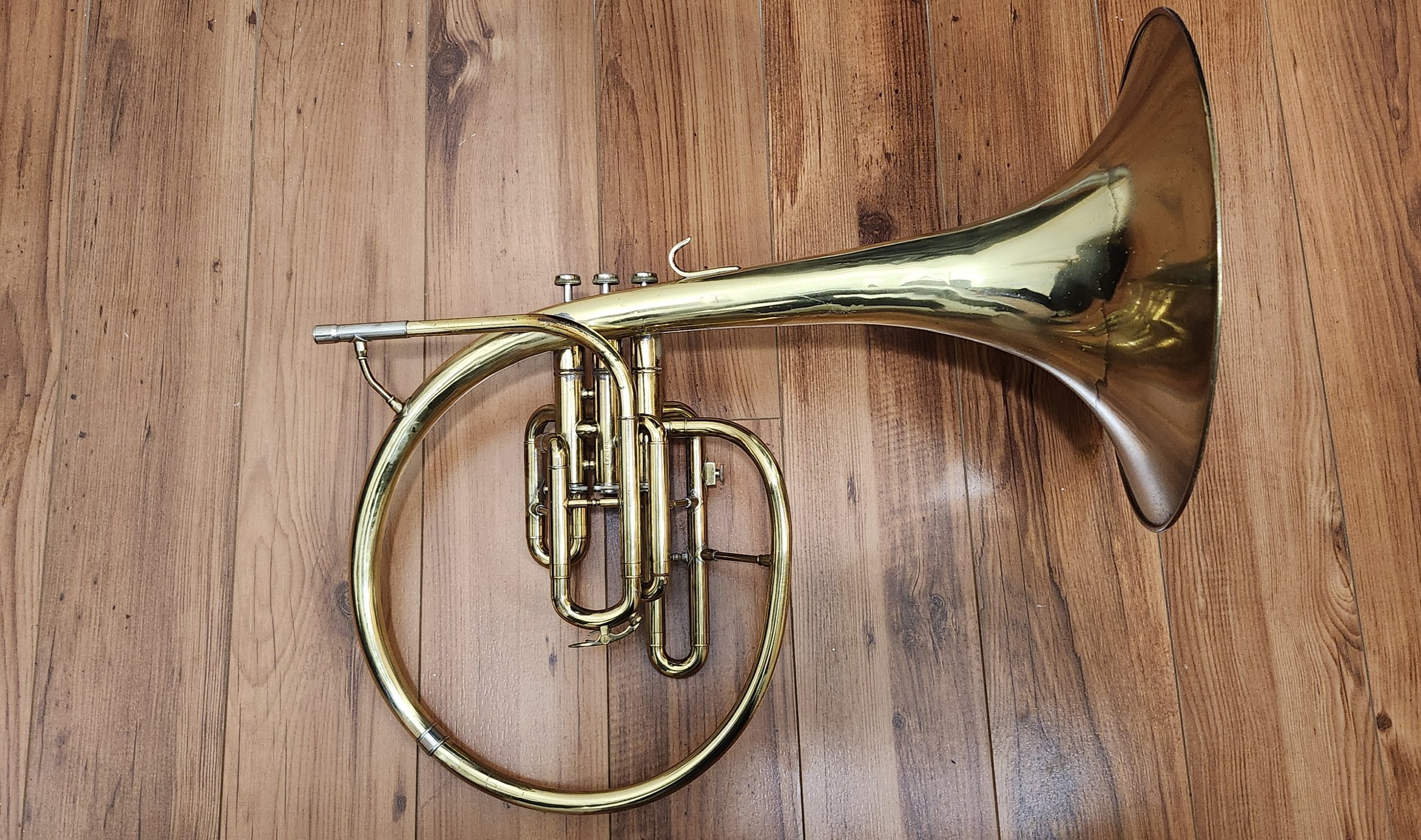Yamaha Mellophone Sisters
The Yamaha YMP-200 series of marching mellophones is the standard by which all other marching mellophones are measured. It is well-known to be arguably the best marching mellophone there is, so it often commands significantly higher prices on the used market than any other brand. The current model, the YMP-204M, is the pinnacle of mellophone design; however, even the first YMP-201M is an excellent instrument leaps and bounds ahead of most other marching brass.
However, the YMP-201M was not the first Yamaha mellophone. That honor goes to the rare and mostly unknown (at least in the West) YMP-201 (no M) circular mellophone.
On the left is a YMP-201, while on the right is a YMP-201M. They’re sisters!
However, the 201M is not just a 201 re-wrapped to point the bell forwards; there are some significant differences. The 201 has a huge 12” bell and a small .449” bore, while the 201M has a more standard 10” bell and .462” bore. The 201 can play in F or E-flat just by rerouting the two tuning slides built into the instrument - no extra slides needed! (This was also a feature on certain York mellophones.) Meanwhile, the 201M only plays in F. The 201 also has the traditional cornet shank, while the 201M uses a trumpet shank like other marching mellophones. Despite the only difference in designation being a single “M”, the two instruments are completely separate designs.
They play and sound different, too. The 201M sounds like a marching mellophone should, has a fabulous upper register, and can sound like an alto flugelhorn with an alto horn mouthpiece. It is light, balanced, and easy to play. The 201 meanwhile has a smaller yet darker sound that blends with anything. While other circular mellophones have more colorful, interesting sounds (my 1925 Buescher 25 and 1918 Conn 6E come immediately to mind), the 201 could be the ultimate gigging circular mellophone. It plays in tune, it has fast modern valves, it has a transparent, chameleon sound, but it can still light up and is easy to play in all registers. It is not the most glamorous circular mellophone, but it just works.
It is also how modern it feels in comparison to all other circular mellophones that makes it as interesting as it is. It feels modern because it IS modern; it started production in the 1980s! From what I have been told by a Japanese source, French horns were too expensive for many school bands in Japan, so they used the traditional mellophone into the 1990s as a French horn substitute. Yamaha thus made the relatively affordable YMP-201 exclusively for the Japanese domestic market, hence why it is so rare in the West.
Of course, like all circular mellophones, the 201 suffers from challenging ergonomics thanks to the downward-facing bell. There are many different ways to hold a circular mellophone, and I’ve demonstrated a few below using my 201 (actually the 2nd 201 I’ve owned, long after I sold the one pictured at the top of the article):
I tend to go with the long brace grip. While still not ideal, it and the vertical clutch grip feel the most balanced and comfortable to me. The valve block and 3rd slide grips force you to hold the instrument vertically so the bell points straight into your body, which is the worst solution acoustically. The bottom bow grip does work, but it feels less stable than the long brace or vertical clutch grips. You can also of course hold the instrument by the bell rim, but that is very uncomfortable. Or you could try putting your hand in the bell like a French horn, but I haven’t found that to be a desirable option.
Speaking from experience, the circular mellophone’s bell pointing down makes it difficult to impossible to hear yourself in an ensemble, so the 201 (like all circular mellophones) is pretty useless for anything but quiet settings and home recording if you keep the bell as-is. (The 201M, on the other hand, can be used anywhere you can get away with using a marching mellophone.)
The best solution to this problem is to have the bell straightened out to turn the 201 into a mellophonium, which is something I bought a second 201 (long after selling the first one) specifically to do. Here is the result:
In this guise, I like to call it a YMP-201E, in homage to the Conn 16E mellophonium. It corrects the 201’s one fatal flaw, and in the process I think it makes it play and sound even better! It is a million times easier to play than the Conn 16E, and has a unique character all its own.







